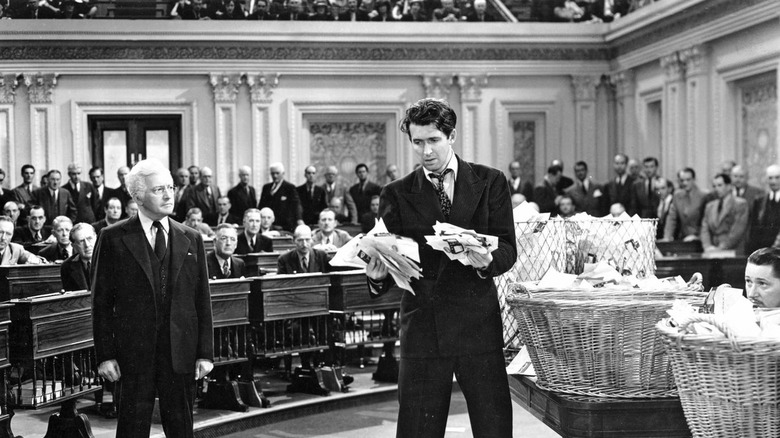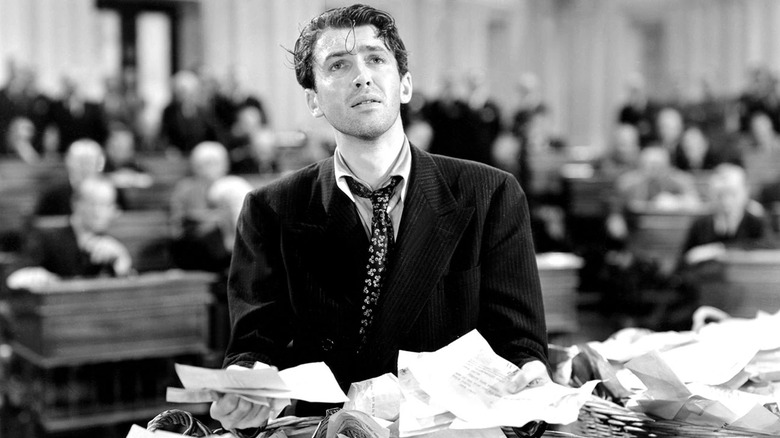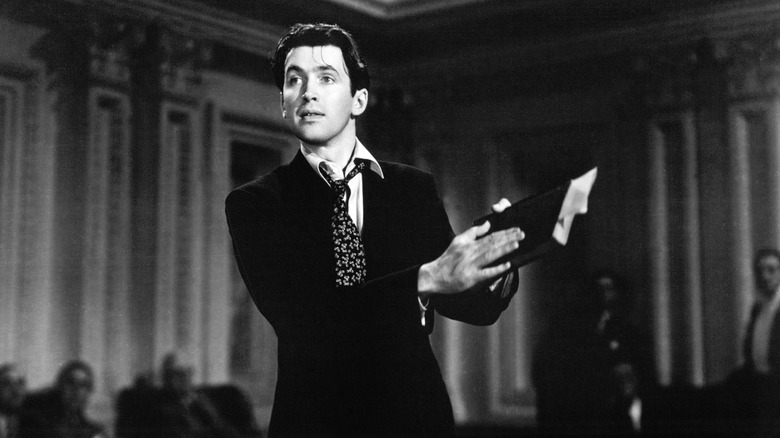James Stewart Needed A Doctor On Deck For Mr. Smith Goes To Washington's Filibuster Scene
Frank Capra made James Stewart into the heart of Hollywood. In their second movie together, "Mr. Smith Goes To Washington," Stewart played Jefferson Smith, a "Boy Ranger" leader in an unnamed Western state. Smith is appointed to fill one of the state's Senate seats after its holder dies. When he arrives in DC, his naïveté and kindness turn him into a reformer. After he's framed for corruption, he embarks on a 24-hour filibuster (a speech on the Senate Floor that cannot be interrupted so long as a Senator has something to say), attempting to rally the people's attention and sway the Senate's conscience.
Smith grows more and more exhausted as the scene goes on, so Stewart's performance had to reflect this. In particular, Capra wanted Stewart's voice to be as hoarse as Smith's should be after speaking for 24 hours straight. To make the voice right, Stewart recruited a doctor — not to safeguard his health, but to muck it up.
Getting a sore throat
The anecdote is recounted in "Jimmy Stewart: A Life in Film" by Roy Pickard. According to Pickard, Capra was unimpressed with Stewart's initial delivery of Smith's closing line: "You think I'm licked. Well, I'm not licked. I'm going to stay right here and fight for this lost cause. Somebody will listen to me." Capra thought Stewart sounded like, "an actor trying to put on a voice with a rasp."
So, when shooting wrapped for the day, Stewart went to a doctor and asked if the man could make his throat sore. As Stewart recalled, this was the doctor's dumbfounded response:
"I've heard you Hollywood folk are kinda crazy, but you take the cake. You want me to give you a sore throat. It's taken me twenty-five years of study and practice to keep people from getting sore throats. Now you want me to give you one... OK, I'll give you the sorest throat you've ever had."
To do so, the doctor chose mercury dichloride, dropping it down Stewart's mouth to produce a raspy throat. He even accompanied Stewart to shooting the next day, ready to make his throat scratchy again should the mercury wear off.
History of the filibuster
A real-life filibuster rivaling the length of Jefferson Smith's fictional one was one by Senator Strom Thurmond (D-SC) on August 28, 1957. Thurmond did this for much less noble reasons than Senator Smith: he was blocking the 1957 Civil Rights act, designed to grant voting rights protections to African-Americans. Thankfully, the effort was also in vain, unlike Smith convincing Senator Paine (Claude Rains) to reform.
Talking filibusters in this ilk aren't much of a thing anymore. In the 21st century, "filibusters" mean bills are routinely blocked when 41 or more senators vote "no" on a motion for cloture (or an end to debating the bill). There are some exceptions, though. Senator Bernie Sanders (I-VT) partook in an 8-and-a-half-hour filibuster on December 10, 2010, against the 2010 Tax Relief Act. A few years later on March 6, 2013, Senator Rand Paul (R-KY) did a 13-hour filibuster against the nomination of John Brennan as CIA director. However, such filibusters are definitely not the norm and are done to drum up publicity for pet issues, not actually affect change.
To understand the history and current use of the filibuster, read "Kill Switch: The Rise of the Modern Senate and the Crippling of American Democracy" by Adam Jentleson, former deputy chief of staff to late Senator Harry Reid (D-NV). "Mr. Smith Goes To Washington" holds up as stirring, idealized entertainment, but in the 2020s, it shouldn't be taken as a civics lesson.


